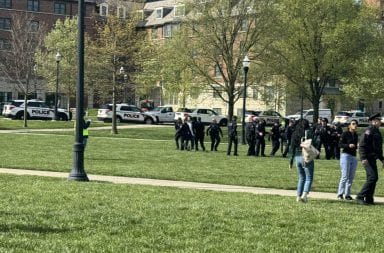“In an investigation of this sort, we try to look at everything.”
That’s what Earl Weener, member of the National Transportation Safety Board, said in a press conference Wednesday evening held to discuss the train derailment and explosion that occurred at about 2:05 a.m. Wednesday.
The cause of the accident is still unknown, and Weener said “it’s too early to rule anything out.”
Weener revealed that a 12-person team from NTSB will be investigating the incident on scene for the next 7 to 10 days, but it could be a year to 18 months before a probable cause to the accident is determined.
He said the team is made up of “staff with expertise in rail equipment, hazards, materials and emergency response.”
Weener said the on-scene investigation is preliminary to “months of additional fact gathering, followed by analysis of all those facts, and that’s where we come up with findings, conclusions and probable cause.”
While no conclusions have been drawn, Weener said, sabotage cannot be ruled out.
The Norfolk Southern train, a little over a mile long, was southbound heading to Linwood, N.C., when it derailed, carrying 12,319 tons of dead weight in mixed freight. The crew had a clear signal and saw nothing unusual shortly before the incident occurred, shortly after entering a 25 mph speed limit curve that Weener called “aggressive.” The train was moving at a speed of 23 mph when “undesirable breaking” occurred.
The emergency stop took 20 seconds, in which time the train traveled 372 feet. The train carried three ethanol cars, two corn syrup cars, eight wheat cars, and four cars of mulch as it derailed.
Weener made no mention of the hazardous chemical styrene that was onboard the train at that time.
Weener said “the speed was where it was supposed to be coming in for the curve,” and not immediately thought to be a contributing factor in the derailment.
The track had been inspected with ultrasonic and induction testing on April 5, which looks for any potential anomalies and is done three times per year. The track had also been visually inspected on Monday by an inspector driving the track, a safety check that is done twice a week.
The crew operating that train had been on board since about 7:55 p.m. Tuesday, and had been working for roughly seven hours before the incident, an amount of time that Weener said was typical.
Wednesday night NTSB worked to re-rail cars that be can be re-railed and removed from the area, and Weener said they have plans to reconstruct the rails Friday.
Lead railroad investigator on the case, Cy Gura, said he expects the track to reopen within two to three days.
The Columbus Division of Fire is continuing to let the remaining ethanol burn off, but Weener said the fire is being contained.
A NTSB representative said they would be holding another press conference Thursday in the afternoon, but did not give an exact time.
Ohio State students received a university alert about the fire at 3:45 a.m., and another at 8:45 a.m., warning them to avoid the area.
The train was derailed at Fields and 5th avenues, just south of the Ohio State Fairgrounds.


